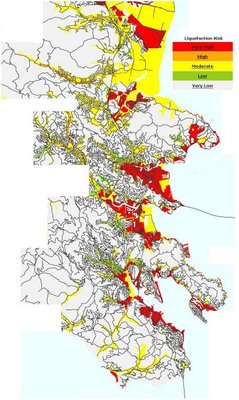The Bay Area recently "celebrated" (although "commemorated" might be a better term) the centennial of the infamous 1906 earthquake that devastated San Francisco and rocked the fledgling Marin County. REskeptic sent me a lot of great info about fault lines and such in Marin (did you know there is a fault line that runs right through Mill Valley?). Hopefully, he will post an in-depth article (hint, hint) about earthquake risk in Marin as it turns out that he is quite knowledgeable in that subject.
However, I found a nice USGS
site showing the risk of
liquefaction in various areas of the Bay Area. I pieced together bits of the map specific to Marin and show it below (click on it to enlarge it). If you must buy into the Marin POS lifestyle then at the very least you can use this map to assess your risk of losing it all to liquefaction as well as to help you decide whether paying for earthquake insurance is a good idea.


7 comments:
Some of you may notice there's some rather "prime" areas in the red "very high" liquefaction risk zones, including Belvedere lagoon, Paradise, sections of Sausalito and Mill Valley. Not to scare anyone here, but given local history, I think it's wise to understand the risks before you buy. I'm not sure realtors are required to tell buyers about every potenttial risk to their property. In my upcoming post, I'll describe liquefaction in more detail, as well as other potentials of geologic/hydraulic hazards in Marin.
Maybe developing Marin will save lives by preventing the "McMansionizing" of Marin?
LOL. So I guess MALT is a now a humanitarian gesture? Sure, excepting areas along the rift zone such as Stinson bar, Olema and Pt. Reyes Station, much of west Marin is as the map depicts: bedrock and older, more stable deposits.
That said, it's good to know your particular situation, and possible risks.
Liquefaction? Is Marin built on sand? or debris from previous fires? Seems like a lot of rock to me.
I guess that just goes to show that people should rely on the USGS over their own ill-informed notions.
So I guess MALT is a now a humanitarian gesture?
Except that most of the MALT land is in the "white" areas of the map. That means MALT is fencing off the safest land vis-a-vis liquefaction. So if we must pursue this absurd line of reasoning, then MALT is anti-humanitarian.
Marinite, what happened to the map north of Ignacio Boulevard?
If truth be told, I ran out of space while using MS Paint (it's not the most forgiving program or else I am not the most technical person). But people can visit the site I linked to and view it.
When I was in college, I took a course in journalism that mentioned that using overly technically terms was a bad idea. I missed points on a quiz when I couldn't find the "error" that ws the use of the word "epicenter." The teacher insisted that the phrasing shoud be "The earthquake was centered."
I told her, in no uncertain terms, that I was from California, where that term is used all the time, especially by the news networks. Sadly, I don't think I convinced her.
Pursuant to that, I learned the term "alluvial soil" while still in grade school. If you're unfamiliar with that term, it means loose fill soil, such as Bay fill, which is extremely prone to liquefication. Aside from fill it is most often found in silted-up marshlands and former lake beds. Such as the Central Valley.
Just so you know...
This site is also very interesting. It has maps of multiple hazards including earthquakes, floods, storms, etc.
Post a Comment